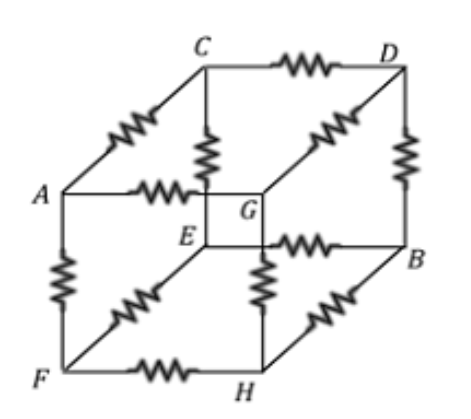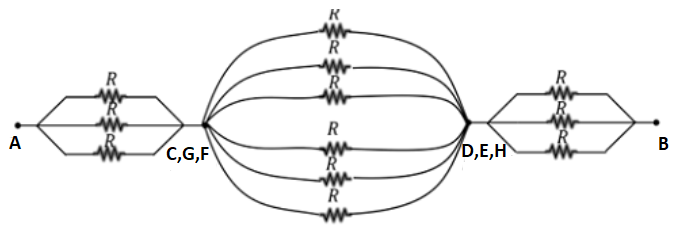
A cube made up of wire each of resistance R. Then find equivalent resistance across the diagonal.

a. $\dfrac{5}{6}R$
b. $\dfrac{3}{4}R$
c. $\dfrac{7}{12}R$
d. $R$
Answer
218.1k+ views
Hint: Here we have to find the equivalent resistance of the circuit in the shape of a cube. First of all, we have to simplify the circuit in order to find out the desired result. Here A and B is considered to be the ends or vertices which contain a diagonal.
Complete answer:
To find the equivalent resistance of the given circuit diagram in the shape of a cube. We have to simplify the cube in a $2$D sketch so that it is easily read or calculated.
Let us consider the diagonal to be AB.
So, we will formulate a sketch based on the $3$D structure of cube to a $2$D flat plane with A and B being the ends, as the question has asked to find out the resistance along a diagonal.
The sketch is formulated as:

Due to symmetry, we have found out that the terminal C,G,F and D,E,H have the same potentials. So, can be regarded as the same point.
Now, the resistance around A and C,G,F are in parallel connection. Again, the resistance along B and D,E,H also the resistances along C,G,F and D,E,H are parallel. While all those three are in series connection.
So, the equivalent resistance is found as,
${{R}_{AB}}=\dfrac{R}{3}+\dfrac{R}{6}+\dfrac{R}{3}$
$\Rightarrow {{R}_{AB}}=\dfrac{5}{6}R$
The correct option is a. $\dfrac{5}{6}R$.
Note: It must be noted that we can figure out the equivalent resistance of anything in a $3$D format. So, our first aim must be to present it in the form of a $2$D sketch. And we must also remember that all the connections must be the same as that of a $3$D figure.
Complete answer:
To find the equivalent resistance of the given circuit diagram in the shape of a cube. We have to simplify the cube in a $2$D sketch so that it is easily read or calculated.
Let us consider the diagonal to be AB.
So, we will formulate a sketch based on the $3$D structure of cube to a $2$D flat plane with A and B being the ends, as the question has asked to find out the resistance along a diagonal.
The sketch is formulated as:

Due to symmetry, we have found out that the terminal C,G,F and D,E,H have the same potentials. So, can be regarded as the same point.
Now, the resistance around A and C,G,F are in parallel connection. Again, the resistance along B and D,E,H also the resistances along C,G,F and D,E,H are parallel. While all those three are in series connection.
So, the equivalent resistance is found as,
${{R}_{AB}}=\dfrac{R}{3}+\dfrac{R}{6}+\dfrac{R}{3}$
$\Rightarrow {{R}_{AB}}=\dfrac{5}{6}R$
The correct option is a. $\dfrac{5}{6}R$.
Note: It must be noted that we can figure out the equivalent resistance of anything in a $3$D format. So, our first aim must be to present it in the form of a $2$D sketch. And we must also remember that all the connections must be the same as that of a $3$D figure.
Recently Updated Pages
Arithmetic, Geometric & Harmonic Progressions Explained

Cartesian Form of Vector Explained: Formula, Examples & Uses

Apparent Frequency Explained: Formula, Uses & Examples

Calorimetry: Definition, Principles & Calculations

Centrifugal Force Explained: Definition, Formula & Examples

Charge in a Magnetic Field: Definition, Formula & Examples

Trending doubts
JEE Main 2026: Application Form Open, Exam Dates, Syllabus, Eligibility & Question Papers

Derivation of Equation of Trajectory Explained for Students

Hybridisation in Chemistry – Concept, Types & Applications

Understanding the Angle of Deviation in a Prism

Understanding Collisions: Types and Examples for Students

Understanding Atomic Structure for Beginners

Other Pages
JEE Advanced Marks vs Ranks 2025: Understanding Category-wise Qualifying Marks and Previous Year Cut-offs

How to Convert a Galvanometer into an Ammeter or Voltmeter

Ideal and Non-Ideal Solutions Explained for Class 12 Chemistry

Degree of Dissociation: Meaning, Formula, Calculation & Uses

Understanding Electromagnetic Waves and Their Importance

Understanding Average and RMS Value in Electrical Circuits




